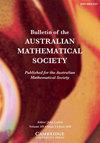NOTES ON FERMAT-TYPE DIFFERENCE EQUATIONS
IF 0.5
4区 数学
Q3 MATHEMATICS
引用次数: 0
Abstract
We consider the existence problem of meromorphic solutions of the Fermat-type difference equation  $$ \begin{align*} f(z)^p+f(z+c)^q=h(z), \end{align*} $$
$$ \begin{align*} f(z)^p+f(z+c)^q=h(z), \end{align*} $$
where  $p,q$ are positive integers, and h has few zeros and poles in the sense that
$p,q$ are positive integers, and h has few zeros and poles in the sense that  $N(r,h) + N(r,1/h) = S(r,h)$. As a particular case, we consider
$N(r,h) + N(r,1/h) = S(r,h)$. As a particular case, we consider  $h=e^g$, where g is an entire function. Additionally, we briefly discuss the case where h is small with respect to f in the standard sense
$h=e^g$, where g is an entire function. Additionally, we briefly discuss the case where h is small with respect to f in the standard sense  $T(r,h)=S(r,f)$.
$T(r,h)=S(r,f)$.
费马型差分方程注释
我们考虑费马型差分方程 $$ \begin{align*}f(z)^p+f(z+c)^q=h(z), \end{align*}的同态解的存在性问题。其中,$p,q$ 为正整数,而 h 的零点和极点很少,即 $N(r,h) + N(r,1/h) = S(r,h)$。作为一种特殊情况,我们考虑 $h=e^g$,其中 g 是一次函数。此外,我们还简要讨论了 h 相对于 f 较小的情况,即标准意义上的 $T(r,h)=S(r,f)$。
本文章由计算机程序翻译,如有差异,请以英文原文为准。
求助全文
约1分钟内获得全文
求助全文
来源期刊
CiteScore
1.20
自引率
14.30%
发文量
149
审稿时长
4-8 weeks
期刊介绍:
Bulletin of the Australian Mathematical Society aims at quick publication of original research in all branches of mathematics. Papers are accepted only after peer review but editorial decisions on acceptance or otherwise are taken quickly, normally within a month of receipt of the paper. The Bulletin concentrates on presenting new and interesting results in a clear and attractive way.
Published Bi-monthly
Published for the Australian Mathematical Society

 求助内容:
求助内容: 应助结果提醒方式:
应助结果提醒方式:


